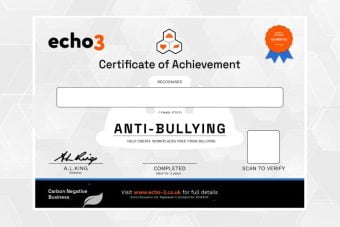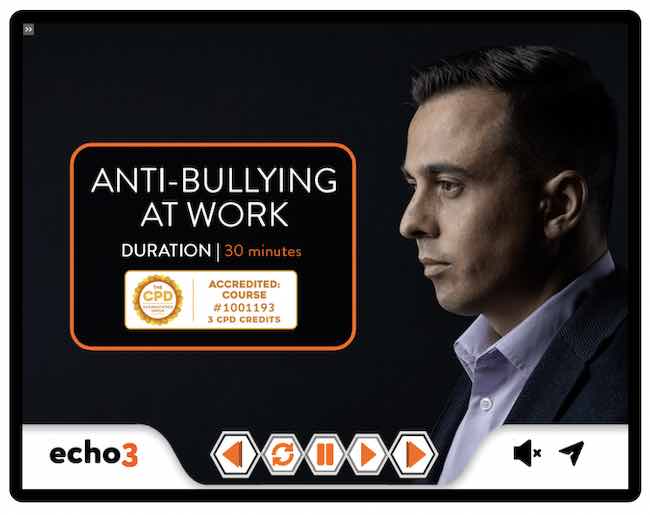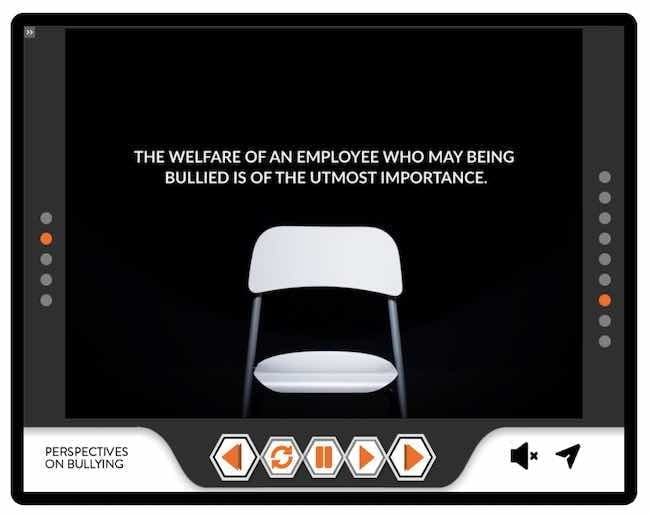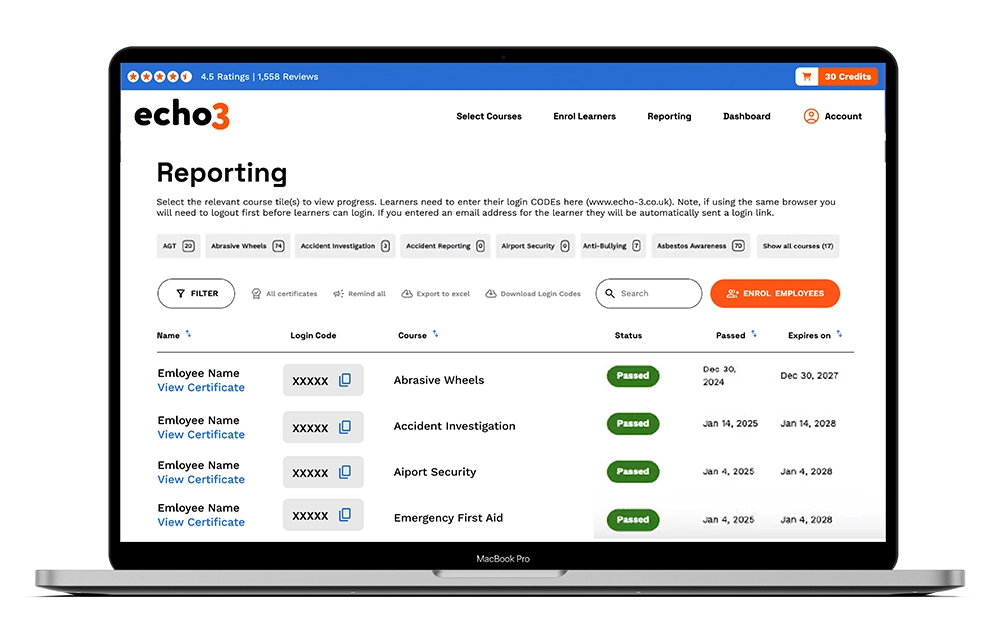Anti-bullying Course
This fully online Anti-Bullying training course from Echo3 is designed for all employees and helps create workplaces free from bullying.
Allowing bullying to exist falls short of an employer’s moral duty to staff and in some serious cases legal duties.
On the other hand, high performing workplaces understand that bullying lowers morale and productivity yet increases absenteeism and staff turnover.
Providing staff with an awareness of the issues around bullying will help your organisation create a healthy culture free from bullying.
Anti-Bullying Course Content
UNIT 1 | WHAT IS BULLYING?
In this unit we will focus on bullying in the workplace. Anyone in the workplace has the potential to be a bully. It can be a manager or supervisor dealing with an employee. Bullying can happen from an employee to a manager, it can happen from one employee to another or group of employees to another group or even a customer or business contact to an employee or employees.
The aim of this unit is to show you how to identify and prevent against it occurring in the first place.
UNIT 2 | PREVENTING & RESOLVING ISSUES
In this unit we will look at how to create an anti-bullying and harassment culture. The aim of this unit is to familiarise you with the policies and procedures, this includes taking you through the complaint process and also the external bodies that are in place to lend support in situations of bullying or harassment.
Anti Bullying Course Certificate
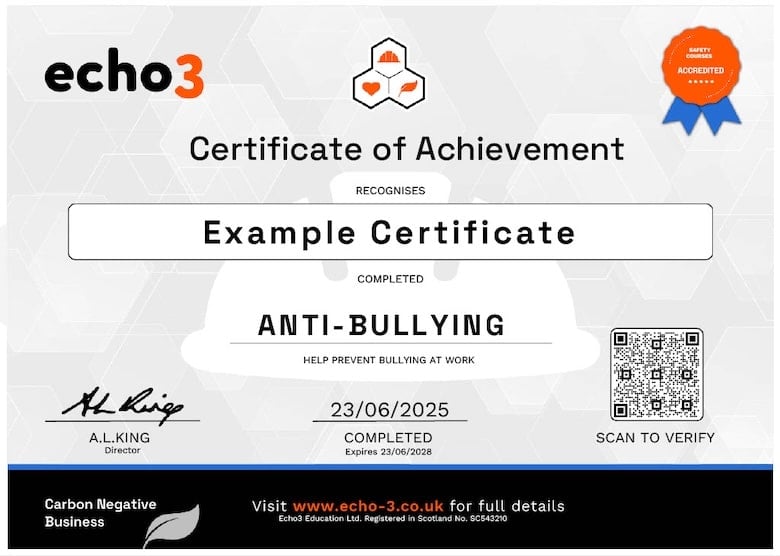
Download and Print Your Certificate
- Written in conjunction with Citizen Advice Scotland
- Developed by qualified health and safety professionals
- Last Updated June 2022
- To gain the certificate you must complete the assessment which involves 10 questions.
- You can access our LMS any time to reprint certificates, check and set pass marks and act as proof of a commitment to ongoing legal compliance.
- The online Anti Bullying certificate is valid for 3 years.
How to use the Echo3 Platform
Individual Learners

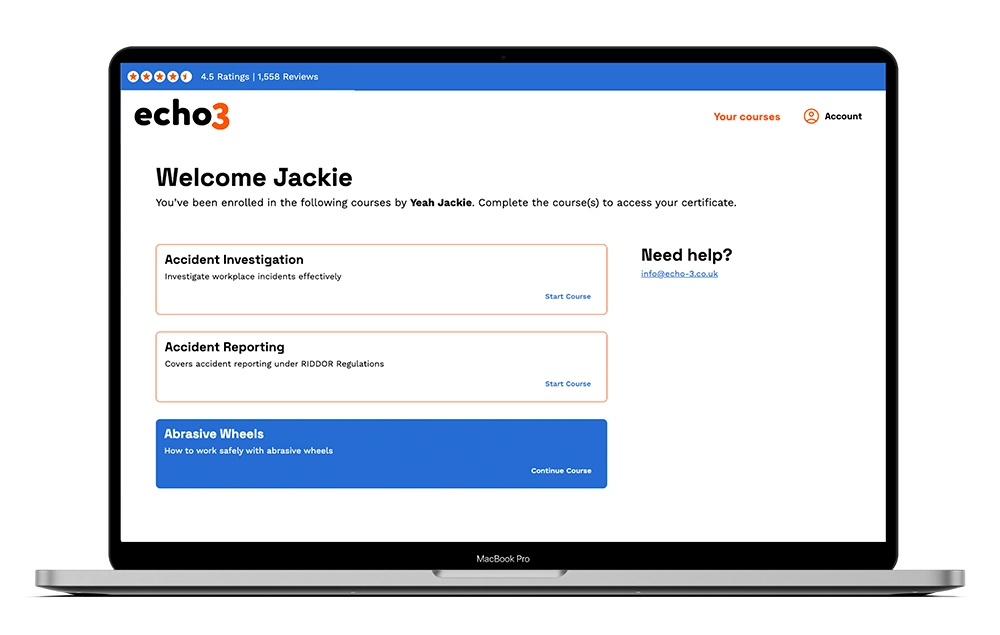
Benefits for Individuals
-
Engaging video-based content
-
Learner dashboard included
-
Instant access after payment
-
Free course retakes
-
Shareable digital certificate
 QR Code Certificate
QR Code Certificate



Bulk Buying Discounts
10 Courses
50 Courses
100+ Courses
Course Preview
Echo3 courses include engaging motion-graphic video content, with full english subtitles
What are the learning outcomes?
By the end of this Anti Bullying course learners will know;
- What bulling is
- Applicable legislation
- The potential impact of bullying
- The difference between bullying and management
- The importance of policies
- Effective bullying prevention measures
- How to handle bullying complaints
NOTE: This course has lessons aimed at addressing bullying. We also offer ‘Dignity in the Workplace‘ that deals with both bullying and harassment.
Who is this course for?
This anti bullying training is for all employees. It is particularly beneficial to managers and supervisors.
What is bullying?
Bullying at work is defined as,
“repeated, inappropriate behaviour, direct or indirect, whether verbal, physical or otherwise, conducted by one or more persons against another or others, at the workplace and/or in the course of employment, which could reasonably be regarded as undermining the individual’s right to dignity at work.”
What are employer’s responsibilities for stopping bullying?
Bullying at work risks the safety, health, and welfare of people at work and can be unlawful under both the Equality Act 2010 and/or the Health and Safety at Work Act 1974.
The Health and Safety at Work Act 1974 requires employers to ensure the health and safety of anyone affected by their work.
Obviously businesses cannot keep everyone safe all the time. But, legal compliance requires employers to take all ‘reasonably practicable‘ steps.
This requires firstly, undertaking a risk assessment.
Secondly, this means implementing appropriate steps to protect the health and safety of staff. For example where bullying is a risk to health, an Anti Bullying course in likely a reasonable step.
How to respond to a bullying compliant?
Employers should treat the welfare of an employee who may being bullied is of the utmost importance. A bullying accusation is a very serious thing and must be dealt with carefully.
There must be an examination into the circumstances and ensure that the bullying actually is or was occurring. Note, An isolated incident, as a once off, is not considered to be bullying.
If the incident is isolated and a low level risk a conversation between HR with the line manager will often be sufficient.
However, if a reported incidents are common or of a serious nature. E.g. physical, repetitive or a group against an individual. Then formal disciplinary action and company-wide training is a more reasonable response.
Unfortunately there are no absolute correct answers. Because the issues around bullying are subjective by their nature.
The seriousness of bullying depends on how it feels to the recipient. What to one person takes as a joke could to another person have a very serious impact on their mental health.
What should you do if you are bullied?
If you are bullied at work it can obviously be distressing.
Firstly, try to approach the person calmly and point out to them that the behaviour was offensive to you, why it was offensive and that you are now asking them to refrain from repeating that behaviour in future.
Alternatively, you could pursue the issue through your companies policies & procedures.
Either way, you should take a note of the incident and the conversation for your own records.
Example of bullying include;
- Sending critical emailed about someone to others who do not need to know
- Demeaning someone – picking on them or setting them up to fail
- Unfair treatment
- Overbearing supervision
- Threats or intimidating comments.
- Undermining a competent worker with constant criticism
- Intentionally blocking promotion or training opportunities







